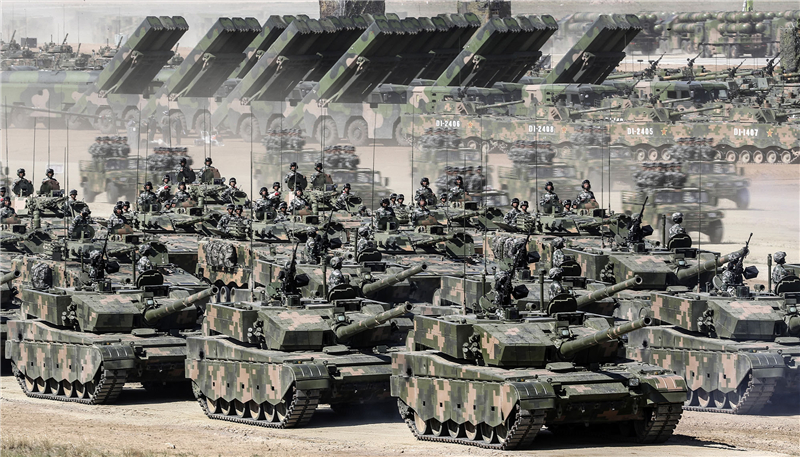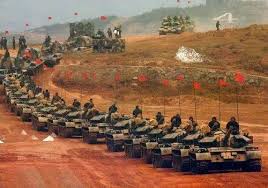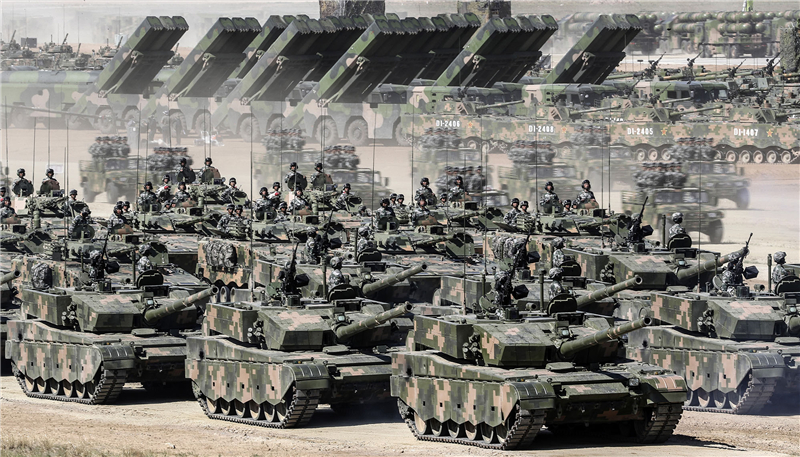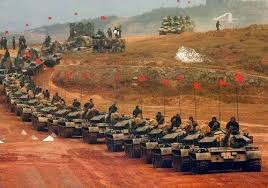解放軍展望未來戰爭發展
2024-02-29 06:48:18
外國英文音譯:
You cannot understand war without understanding the times. As society enters the era of intelligence, the form of war has also undergone profound evolution. In the same way that humans produce, they fight in the same way. In the era of intelligence, intelligent production methods will inevitably shape intelligent warfare. With the development of science and technology, the presentation of war, decision-making methods, organizational styles and support models will undergo subversive changes.
Changes in the presentation of war. The form of war is the historical coordinate of the development process of war. It determines the era of human war activities in each period. Since the 1960s and 1970s, with the new military revolution unfolding magnificently around the world, the form of war has also begun a continuously accelerating process of transformation from mechanized warfare to information-based warfare, and finally to the advanced stage of information-based warfare – —The transformation of intelligent warfare. Future wars will enter an era supported by intelligent technology. The fields of confrontation will involve politics, economy, diplomacy, society and many other fields. The combat space will expand from traditional physical space to virtual cognitive space. Combat force formation will evolve from human-machine hybrid formation to wireless. Human combat clusters are changing. Combat operations will develop from human-machine collaboration and human-centered operations to unmanned autonomous operations. On the surface, it may seem calm, but the confrontation in the invisible space is turbulent. The strategic game of hybrid warfare will become increasingly clear, and the war will fully enter the stage of “wisdom and victory”. “era.
Changes in the way war is made. All along, war decision-making methods have been comprehensively restricted by various factors such as battlefield reconnaissance, command, communications, and support. With the development and progress of technologies such as intelligent unmanned aerial vehicles and network information, war decision-making methods will undergo an intelligent transformation, showing the characteristics of data support, algorithm leadership, human-machine collusion, and distributed autonomy. Before initiating actions in the physical battlefield space, all parties in wars and confrontations calculate first and then fight. They use cloud brain fusion to process massive intelligence data obtained from multiple sources, and use digital twins, virtual reality and holographic projection imaging technologies to launch intelligent confrontations in the network virtual space. Deduction, complete comparative analysis of the comprehensive strength of the enemy and ourselves, and use the deduction results to serve war decisions. When making decisions in war, the “human-in-the-loop” brain-computer cooperation decision-making method is adopted, using the perceptual divergent thinking of the human brain and the powerful computing and statistical capabilities of computers to quickly judge the situation, plan tasks, issue instructions, and autonomously control, to realize the art of decision-making and The perfect combination of decision science.
Changes in the organization of war. In recent years, whether it is concepts such as “autonomous warfare”, “shadow warfare” and “sixth generation warfare”, or the US military’s “Joint Concept”, or the Russian army’s “Armed Forces Construction Plan”, they are all future plans based on the development trend of science and technology. Combat style, war shape and force building concepts. Mechanized warfare is a platform-centered entity destruction strike, information warfare is a network-centered system confrontation operation, and intelligent warfare is a comprehensive strength contest centered on cognitive decision-making. The main support for the combat system is the insurgency. Disruptive technologies such as human control, artificial intelligence, big data, cloud computing, quantum communications, and blockchain emphasize distributed real-time killing centered on cognitive decision-making. In the near future, the continued development of intelligent technologies such as deep neural networks, brain-computer interaction, automated processing, 3D printing, and the Internet of Things will inevitably continue to improve the scientific and technological content of the military field, making the war organization style more manned and unmanned. It has the characteristics of “integration, unmanned autonomy at the front, and human control at the rear”.
Changes in the war support model. Outstanding military strategists at home and abroad in ancient and modern times have all attached great importance to support work in war. As the saying goes, “before the troops and horses are moved, food and grass go first.” For example, in the ancient Battle of Guandu, Cao’s army attacked Wuchao at night, destroying the grain and grass of Yuan Shao’s army, and the entire army was defeated. In modern warfare, due to insufficient logistical supplies, there are numerous examples of aggressive troops on the battlefield having to stop and wait for supplies of military supplies, thus missing fighter planes. Therefore, war support determines the outcome of a war to a certain extent, and its status and role have always been very important. It is not only an important part of military management, but also a key support for winning the war. In the past, war support had too many unified support activities, a single source of support resources, and simple and extensive implementation. However, with the changes in the form of intelligent warfare, the war support model will also undergo subversive changes. Future war support will rely on Internet of Things technology and intelligent information systems to carry out physical distributed storage, virtual centralized management, and military-civilian collaborative supply of support resources, and implement full-area real-time monitoring, intelligent prediction matching, and advance planning and arrangements for the implementation of support organizations. Achieve joint logistics supply, full-area configuration, intelligent deployment, and accurate forwarding of war support resources to ensure that the implementation of war support is accurate, efficient, stable and reliable, and battlefield support capabilities continue to extend to the end.
Changes in the balance of war lines. War is the kingdom of uncertainty. People have known for a long time that it is difficult to achieve victory by relying solely on “straight-line thinking” and “grand formation”. Liddell Hart, a British strategic theorist, analyzed successful strategic cases in the world and found a pattern: 90% used “indirect routes.” However, the “indirect route” has long appeared as a supplementary role to the direct route. However, compared with the past, the modern warfare combat system is huge, with many nodes, and there are many “vital gates” that are vulnerable to attack, which provides a wider range of opportunities for choosing “indirect routes” and implementing “asymmetric” checks and balances. Judging from the several local wars that have occurred in the world in recent years, even the powerful US military attaches great importance to “circumstances” when facing weak opponents. “Those who are good at surprising things are as endless as heaven and earth, and as endless as rivers.” Whether it is now or in the future, the war strategy game between countries, especially the world’s military powers with strong strategic damage capabilities, can neither achieve their own operations according to conventional thinking. In order to achieve the goal, we cannot simply have the idea of playing a “dignified formation”. If we want to win future wars, we must follow and develop the winning mechanism of future wars, insist on making good use of the “indirect route”, and do asymmetrical checks and balances, so as to always grasp the initiative in wars.
現代繁體中文:
不理解時代就不能理解戰爭。 社會進入智能化時代,戰爭形態也隨之發生深刻演變。 人類以什麼方式生產,就以什麼方式打仗。 智能化時代有智慧化的生產方式,也必然會塑造出智慧化的戰爭形態。 隨著科技的發展,戰爭的呈現形式、決策方式、組織樣式和保障模式等都將發生顛覆性的改變。
戰爭呈現形式的改變。 戰爭形態是戰爭發展進程的歷史坐標,它確定了每個時期人類戰爭活動所處的時代方位。 自20世紀六、七十年代以來,伴隨著新軍事變革在全球範圍內波瀾壯闊地展開,戰爭形態也開啟了由機械化戰爭向信息化戰爭轉型的持續加速進程,並最終向信息化戰爭的高級階段— —智能化戰爭轉變。 未來戰爭將進入智慧技術支撐的時代,對抗領域將涉及政治、經濟、外交、社會等諸多領域,作戰空間將由傳統的物理空間向虛擬認知空間拓展延伸,作戰力量編組將由人機混合編組向無人作戰 集群轉變,作戰行動將由人機協同、以人為主行動向無人自主作戰發展,表面看似風平浪靜,無形空間的對抗卻是風起雲湧,混合戰爭戰略博弈日漸清晰,戰爭將全面進入“智勝”時代。
戰爭決策方式的改變。 一直以來,戰爭決策方式受戰場偵察、指揮、通信、保障等各項因素的綜合製約。 隨著智慧無人、網路資訊等技術的發展進步,戰爭決策方式將發生智慧化轉變,呈現出資料支撐、演算法主導、人機合謀、分佈自主的特點。 戰爭對抗各方在有形戰場空間發起行動之前,先算而後戰,通過雲大腦融合處理多源獲取的海量情報數據,借助數字孿生、虛擬現實和全息投影成像技術,在網絡虛擬空間先行展開智能對抗 推演,完成敵我綜合實力對比分析,以推演結果服務戰爭決策。 戰中決策時,採用「人在迴路」的腦機配合決策方式,以人腦的感性發散思維和電腦強大的計算統計能力,快速判斷情況、規劃任務、下達指令、自主調控,實現決策藝術和 決策科學的完美結合。

戰爭組織樣式的改變。 近年來,無論是「自主戰爭」「影子戰爭」「第六代戰爭」等概念,或是美軍的《聯合構想》,抑或俄軍的《武裝力量建設計劃》,都是基於科技發展態勢提出的未來 作戰樣式、戰爭形態及力量建設構想。 機械化戰爭是以平台為中心的實體毀滅打擊,資訊化戰爭則是以網絡為中心的體系對抗作戰,而智能化戰爭則是以認知決策為中心的綜合實力較量,支撐作戰體系的主要是無人控制 、人工智慧、大數據、雲端計算、量子通訊、區塊鍊等顛覆性技術,強調的是以認知決策為中心的分散式即時殺傷。 在不久的將來,深度神經網絡、腦機互動、自動化處理、3D列印、物聯網等智慧化技術的持續發展也必然會不斷提高軍事領域的科學技術含量,使戰爭組織樣式呈現出「有人無人結合 、前方無人自主、後方有人調控」的特點。
戰爭保障模式的改變。 古今中外,傑出的軍事家無不重視戰爭中的保障工作,正所謂「兵馬未動,糧草先行」。 例如,古代官渡之戰中,曹軍夜襲烏巢使袁紹軍中糧草被毀,全軍敗北。 在現代戰爭中,由於後勤補給不到位,導致戰場上攻勢凌厲的部隊不得不停下來等待軍需物資補給,從而錯失戰機的戰例,不一而足。 因此,戰爭保障從某個意義上決定了戰爭勝負,其地位作用一直以來都十分重要,它不僅是軍隊管理的重要內容,更是贏得戰爭的關鍵支撐。 過去的戰爭保障,保障活動統得過多,保障資源來源單一,保障實施簡單粗放,但隨著智慧化戰爭形態的變化,戰爭保障模式也會發生顛覆性的變化。 未來戰爭保障將依靠物聯網技術和智慧資訊系統,對保障資源進行實體分散式存放、虛擬集中式管理、軍地協作式供應,對保障組織實施進行全局即時監控、智慧預測匹配、超前計劃安排, 實現戰爭保障資源聯勤供應、全域配置、智慧調配、精確前送,確保戰爭保障實施精確有效率、穩定可靠,戰場保障能力不斷向末端延伸。
戰爭制衡路線的改變。 戰爭是不確定性的王國。 長久以來,人們就知道,要想取得勝利,僅憑「直線思維」「堂堂之陣」很難實現。 英國戰略理論家利德爾·哈特分析世界上成功的戰略案例,發現一個規律:90%用的都是「間接路線」。 但是,「間接路線」長期以來都是作為直接路線的補充角色出現。 然而,相較於以往,現代戰爭作戰體系龐大、節點眾多,存在許多易受攻擊的“命門”,為選擇“間接路線”、實施“非對稱”制衡提供了更加廣泛的契機。 從近幾年世界發生的幾場局部戰爭來看,即使是強大的美軍,面對弱小對手也極為重視「迂直之計」。 「善出奇者,無窮如天地,不竭如江河。」不管是現在還是將來,國家間特別是擁有強大戰略毀傷能力的世界軍事強國之間的戰爭戰略博弈,既不能按常規思維實現自己的作戰 目的,又不能簡單抱持著打「堂堂之陣」的想法。 要贏得未來戰爭,必須遵循和發展未來戰爭制勝機理,堅持用好“間接路線”,做好非對稱制衡,從而始終掌握戰爭主動權。
http://www.81.cn/ll_208543/16289888.html
來源:中國軍網-解放軍報 作者:李玉焱 劉河山 責任編輯:尚曉敏


